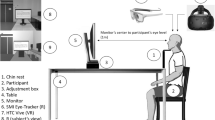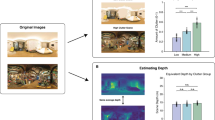Abstract
Supporting smooth target acquisition is an important objective in immersive virtual reality (VR) environments. However, users were obliged to search for objects relying on the vision channel in traditional VR systems. Such eyes-engaged technologies may significantly degrade the interaction efficiency and user experience, particularly when users have to turn their head frequently to search for virtual objects in the limited field of view of a head-mounted display. In this paper, we report a two-stage study which investigates the capability of VR users to acquire spatial targets without eye engagement (i.e., eyes-free target acquisition). First, we measure the eyes-free performance of users in terms of control accuracy and subjective task load. Second, we evaluate the effects of eyes-free acquisition on memory capacity, spatial offset, and task completion time in the context of a VR game. Starting from a set of 54 spatial positions, we identify 18 optimal locations (half on the left side of the user’s body and half on the right) that allow both accurate and comfortable target acquisition without visual attention. After a short training period, users could accurately and quickly acquire 17 targets in a VR game with an average offset of 10.5 cm and an average completion time of 2.7 s. According to our results, we suggest how to optimize the spatial layout, number of targets, target locations, and interaction techniques for eyes-free acquisition in VR applications. Our work can serve as a foundation for future development of eyes-free methods of target acquisition in VR.









Similar content being viewed by others
References
Argelaguet F, Andujar C (2013) A survey of 3D object selection techniques for virtual environments. Comput Graph 37(3):121–136
Caluya NR, Plopski A, Ty JF, Sandor C, Taketomi T, Kato H (2018) Transferability of spatial maps: augmented versus virtual reality training. In: 2018 IEEE conference on virtual reality and 3D user interfaces, pp 387–393. IEEE
Cheng C, Jiang R, Dong XM (2012) Human knowledge acquisition from 3D interaction in virtual environments. Sci China Inform Sci 55:1528–1540
Cockburn A (2004) Revisiting 2D vs 3D implications on spatial memory. In: Proceedings of the fifth conference on Australasian user interface, 28, pp 25–31. Australian Computer Society, Inc.
Cockburn A, Quinn P, Gutwin C, Ramos G, Looser J (2011) Air pointing: design and evaluation of spatial target acquisition with and without visual feedback. Int J Hum Comput Stud 69(6):401–414
Cockburn A, McKenzie B (2002) Evaluating the effectiveness of spatial memory in 2D and 3D physical and virtual environments. In: Proceedings of the SIGCHI conference on human factors in computing systems, pp 203–210, ACM
De Lillo C, James FC (2012) Spatial working memory for clustered and linear configurations of sites in a virtual reality foraging task. Cognit Process 13(1):243–246
Deng CL, Geng P, Hu YF, Kuai SG (2019) Beyond Fitts’s law: a three-phase model predicts movement time to position an object in an immersive 3D virtual environment. Hum Factors 61(6):879–894
Edge D, Blackwell AF (2009) Peripheral tangible interaction by analytic design. In: Proceedings of the 3rd international conference on tangible and embedded interaction, February, pp 69–76. ACM
Fine JM, Ward KL, Amazeen EL (2014) Manual coordination with intermittent targets: velocity information for prospective control. Acta Psycholog 149:24–31
Forsberg A, Herndon K, Zeleznik R (1996) Aperture based selection for immersive virtual environments. In: Proceedings of the 9th annual ACM symposium on user interface software and technology, pp 95–96. ACM
Gacem H, Bailly G, Eagan J, Lecolinet E (2016) Impact of motorized projection guidance on spatial memory. In: Proceedings of the 2016 symposium on spatial user interaction, pp 51–59
Gold T (1972) The limits of stereopsis for depth perception in dynamic visual situations. In: Engineering data compendium. Human perception and performance. Edited by Kenneth R. Boff and Janet E. Lincoln. Volume 2. Chapter 5. pp 1053–1128
Grossman T, Balakrishnan R (2005) The bubble cursor: Enhancing target acquisition by dynamic resizing of the cursor’s activation area. In: Proceedings of the SIGCHI conference on human factors in computing systems, pp 281–290. ACM
Hart SG, Staveland LE (1988) Development of NASA-TLX (Task Load Index): results of empirical and theoretical research. Adv Psychol 52:139–183
Henry D, Furness T (1993) Spatial perception in virtual environments: Evaluating an architectural application. In: Proceedings of IEEE virtual reality annual international symposium, pp 33–40. IEEE
HTC. https://www.vive.com/cn/product/vive-pro-full-kit/. Retrieved May 28. 2020.
Kölsch M, Beall AC, Turk M (2003) The postural comfort zone for reaching gestures. In: Proceedings of the human factors and ergonomics society annual meeting, 47(4), 787–791. SAGE Publications
Anacken LV, Grossman T, Coninx K (2007) Exploring the effects of environment density and target visibility on object selection in 3D virtual environments. In: 2007 IEEE symposium on 3D user interfaces. IEEE
LaViola JJ Jr, Kruijff E, McMahan RP, Bowman DA, Poupyrev IP (2017)“3D user interfaces: theory and practice, 2nd ed. Addison-Wesley Professional
Li FCY, Dearman D, Truong KN (2009) Virtual shelves: interactions with orientation aware devices. In: Proceedings of the 22nd annual ACM symposium on user interface software and technology, pp 125–128
MacLean A, Young RM, Bellotti VME, Moran TP (1991) Questions, options, and criteria: elements of design space analysis. Hum-Comput Interact 6(3):201–250
Matheis RJ, Schultheis MT, Tiersky LA, DeLuca J, Millis SR, Rizzo A (2007) Is learning and memory different in a virtual environment? Clin Neuropsychol 21(1):146–161
Mathews M, Challa M, Chu CT, Jian G, Seichter H, Grasset R (2007) Evaluation of spatial abilities through tabletop AR. In: Proceedings of the 8th ACM SIGCHI New Zealand chapter’s international conference on computer-human interaction: design centered HCI, July, pp 17–24
McMahan RP, Kopper R, Bowman DA (2015) Principles for designing effective 3D interaction techniques. Handbook of virutal environments: design, implementation, and applications. 2nd ed., K. Hale and Stanney, K. CRC Press, Boca Raton, FL, pp 285–311
Penumudi SA, Kuppam VA, Kim JH, Hwang J (2020) The effects of target location on musculoskeletal load, task performance, and subjective discomfort during virtual reality interactions. Appl Ergon 84:103010
Pierce JS, Forsberg AS, Conway MJ, Hong S, Zeleznik RC, Mine MR (1997) Image plane interaction techniques in 3D immersive environments. In: Proceedings of the 1997 symposium on interactive 3D graphics, pp 39–ff. ACM
Ragan ED, Scerbo S, Bacim F, Bowman DA (2017) Amplified head rotation in virtual reality and the effects on 3D search, training transfer, and spatial orientation. IEEE Trans Visual Comput Graph 23(8):1880–1895
Ramcharitar A, Teather RJ (2018) “EZCursorVR: 2D selection with virtual reality head-mounted displays. In: Proceedings of the 44th graphics interface conference, June, pp 123–130, ACM
Tavanti M, Lind M (2001) 2D vs 3D, implications on spatial memory. In: IEEE symposium on information visualization, pp 139–145. IEEE
Tu H, Huang S, Yuan J, Ren X, Tian F (2019) Crossing-based selection with virtual reality head-mounted displays. In: Proceedings of the 2019 CHI conference on human factors in computing systems, pp 1–14. ACM
Vogel D, Balakrishnan R (2005) Distant freehand pointing and clicking on very large, high resolution displays. In: Proceedings of the 18th annual ACM symposium on user interface software and technology, pp 33–42
Ware C, Lowther K (1997) Selection using a one-eyed cursor in a fish tank VR environment. ACM Trans Comput-Hum Interact 4(4):309–322
Wickens CD, Olmos O, Chudy A, Davenport C (1997) Aviation display support for situation awareness,” (No. ARL-97–10/LOGICON-97–2). University of Illinois at Urbana-Champaign Aviation Research Lab.
Wilcox LM, Allison RS, Elfassy S, Grelik C (2006) Personal space in virtual reality. ACM Trans Appl Percept 3(4):412–428
Worden A, Walker N, Bharat K, Hudson S (1997) Making computers easier for older adults to use: area cursors and sticky icons. In: Proceedings of the ACM SIGCHI conference on human factors in computing systems, pp 266–271. ACM
Wu HY, Yang LQQ (2019) User-defined gestures for dual-screen mobile devices. Int J Hum-Comput Interact 36(10):978–992. https://doi.org/10.1080/10447318.2019.1706331
Xiao R, Benko H (2016) Augmenting the field-of-view of head-mounted displays with sparse peripheral displays. In: Proceedings of the 2016 CHI conference on human factors in computing systems, pp 1221–1232. ACM
Yan Y, Yu C, Ma X, Huang S, Iqbal H, Shi Y (2018) Eyes-free target acquisition in interaction space around the body for virtual reality. In: Proceedings of the 2018 CHI conference on human factors in computing systems, pp 1–13
Zhou Q, Yu D, Reinoso MN, Newn J, Goncalves J, Velloso E (2020) Eyes-free target acquisition during walking in immersive mixed reality. IEEE Trans Visual Comput Graph 26(12):3423–3433
Acknowledgements
The authors wish to thank the anonymous reviewers for their insightful comments. We also want to thank Wanying Feng, Wanxue Xu, and Jinfang Zhang for their help in user interviews and data collection. This work was supported by the National Natural Science Foundation of China under Grant No. 61772564 and the Guangdong Basic and Applied Basic Research Foundation under Grant No. 2021A1515011990.
Author information
Authors and Affiliations
Corresponding author
Ethics declarations
Conflict of interest
The authors declare that they have no potential conflicts of interest with respect to the research, authorship, and/or publication of this article.
Additional information
Publisher's Note
Springer Nature remains neutral with regard to jurisdictional claims in published maps and institutional affiliations.
Supplementary Information
Below is the link to the electronic supplementary material.
Supplementary file1 (MP4 55911 kb)
Rights and permissions
About this article
Cite this article
Wu, H., Huang, K., Deng, Y. et al. Exploring the design space of eyes-free target acquisition in virtual environments. Virtual Reality 26, 513–524 (2022). https://doi.org/10.1007/s10055-021-00591-6
Received:
Accepted:
Published:
Issue Date:
DOI: https://doi.org/10.1007/s10055-021-00591-6




